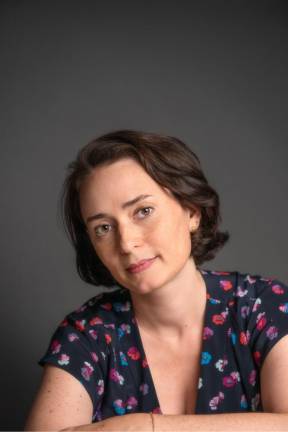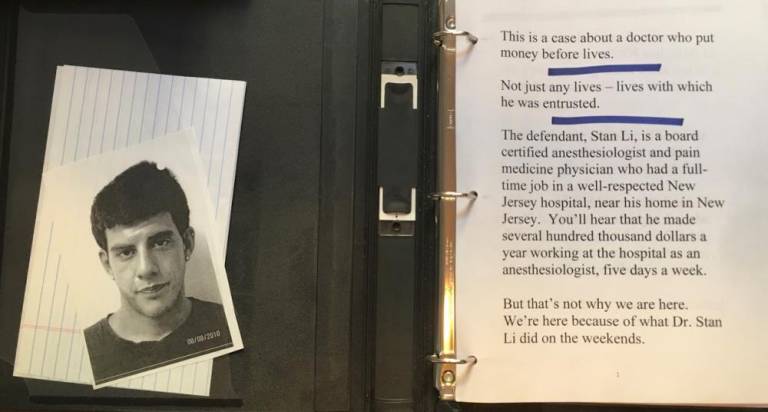Charlotte Bismuth was only a rookie assistant district attorney in the Office of the Special Narcotics Prosecutor for the City of New York when she was handed a Post-it that would change her life. What was written on that tiny piece of paper was a tip that had been called into the office with just a doctor’s name and street scrawled on it, and it was her responsibility to investigate. The next four years of her life were spent doing just that.
It turned out that Dr. Stan Li, a New Jersey anesthesiologist by day, was running a pain management basement clinic in Flushing, Queens on weekends. Patients would actually line up outside and he would see sometimes more than 100 of them a day, writing prescriptions for controlled substances like oxycodone and Xanax for set amounts of cash, which he pocketed, literally, in his medical coat.
From the time she received the tip in December of 2010, to the trial in March of 2014, Bismuth, along with her OSNP colleagues, went through 1,200 patient files and spoke to countless witnesses, 72 of whom testified, including patients and their grieving families. Through their findings, Li was charged, and ultimately found guilty of two counts of reckless manslaughter for the deaths of 21-year-old Nicholas Rappold and Joseph Haeg, 37. This was the first time in New York state that a doctor faced homicide charges for the overdoses of his patients. “He knew that there were patients not only who had overdosed, but who were reselling the medications, stealing the medications, using them to try to commit suicide, and yet, he continued to prescribe,” she explained.
During the 18-week trial at 111 Centre Street, where the criminal branch of the New York State Supreme Court is housed, Bismuth, an Upper East Side resident, not only had the case on her mind “every moment that” she “was awake,” but was also going through the aftermath of a divorce while raising her two children. She’s since welcomed two more little ones with her second husband, who encouraged her to write the book. “Bad Medicine: Catching New York’s Deadliest Pill Pusher,” was published on January 19th.
Dr. Li passed away from COVID while he was serving his sentence in state prison. “I’m sorry for his family and I don’t think it serves justice for him to have died what must have been a very solitary and scary death,” Bismuth said.
Give us a description of what Dr. Li did in his clinic and what kinds of medicine he was prescribing.
Dr. Li was exploiting the pain of his patients for the sake of greed. He had a weekend-only basement clinic where, instead of appointments, he gave out numbered tickets ... He wrote cookie-cutter prescriptions for oxycodone and Xanax without medical justification, sold them for a listed price of either $100 or $150 cash, with extra cash fees if he knew that patients were getting controlled substances from other doctors or taking them other than as prescribed, or planning to use the medication to hurt themselves.
What was the argument from the defense and how did you and your colleagues go against it?
The argument from the defense followed the Big Pharma playbook, which is to say doctors have discretion, they rely on the patients to tell them the truth, these drugs are not very addictive unless the patient intends to get a high from them or misuses them, in which case, whatever happens is the patient’s fault. And the fact is that Dr. Li’s patients admitted on the stand, at least some of them, that they had lied to him about getting medications from other prescribers. What we were able to prove though, and the way that we countered this medical defense, was to show that it was all about the money. So while he was battling on medical grounds, we countered by saying, “You knew they were getting drugs from other doctors, in fact, you charged them extra when you found that out, and you knew that patients were dying and you were running a very lucrative business. He was taking home, on a busy weekend day, close to $7,000 in cash.
When you heard the word “guilty,” what was going through your mind?
I will never forget that moment. In the moment before, in New York State courtrooms, when you’re about to hear a verdict on a homicide charge, the court officers come in, and they all have heavy weaponry. It was quite intimidating ... and it got really, really quiet. And I thought the courtroom was empty, because we’d gotten the note about the verdict and hustled into court very quickly. And at one moment, I turned around and the courtroom was so full, and I told Peter [Kougasian, her trial partner] to turn around. And we thought, “Well, no matter what happens, at least we did the work and we got the truth out there.” And then there’s all this administrative stuff you have to go through before you actually get to that first charge, and I remember I had my pen in my hand, hovering above the chart that I had created, hovering above the box for that first charge, and all I could do was just make a check without betraying any emotion, because I couldn’t. It was like an out-of-body experience.
After the trial, Peter was diagnosed with ALS, and you read him the manuscript of “Bad Medicine” while he was in the hospital.
I never thought that I would look back fondly on the days of the investigation and trial because we were all so stressed out and there were deaths happening on our watch and it was just awful. But now, when I think about it, my friend was at the height of his health and capacity. He was marshaling all of this experience and knowledge. Every day in court he was doing amazing legal work. And when we were waiting for the verdict, he did little magic tricks for us outside the courtroom. And now, he is almost fully paralyzed. Last time I saw him, which was before COVID, he could move his eyebrows a little bit and wiggle his toes. He’s hospitalized; he’s in a tremendous amount of pain. But his mind is still intact. And I went in to read the book to him, because I wanted to make sure that there was nothing in the book that I wouldn’t say straight out to him. And that was a really unforgettable experience.
In your Author’s Note, you said that the hardest part of writing the book was reaching out to the victims’ families. Are you still in touch with them?
It was daunting to reach out because when people are in so much grief, we all have this natural reaction of not knowing what to say or if they want to hear from us. It turned out to be such a gift because now that I was no longer a prosecutor, we could become friends. I can’t tell you how much they bring to my life. Margaret Rappold [Nicholas’ mother] is one of the most important people in my life. Erin Kingsley Markevitch [daughter of former patient of Dr. Li, Kevin Kingsley, who passed away in 2010], Joe Haeg’s family. Even two of the jurors who sat on the case who ended up getting married, we’ve stayed in touch now.
Tell us about the victims and their families.
Nicholas Rappold was a great athlete, a great friend. His mother, the first time that we met her, said, “He was no angel.” She knew that he was struggling and tried to love and help him through, and even signed him up for medication-assisted treatment. One of the hardest parts about the case was meeting all of these families who thought it was their fault, that they hadn’t done enough to save their loved one. It was both a relief and extremely painful to them to realize that there was nothing they could have done. Because they were battling a force that was much stronger than them, and that force was greed. Joseph also died also alone, in his home. Nicholas died in his car. He was also very much loved. He was an uncle and a brother. Joe’s sister had really seen the deterioration of her brother and tried to warn him over and over again that she was afraid he was going to die. In fact, she filmed a video of him one night and her plan was to show him the video and how much he changed and how awful he looked, and she never had a chance to do. But the jury saw that video. It was really a heavy moment in the courtroom because you saw this really handsome guy trying to eat a pizza, barely able to get the words out or to get control of his hands.

